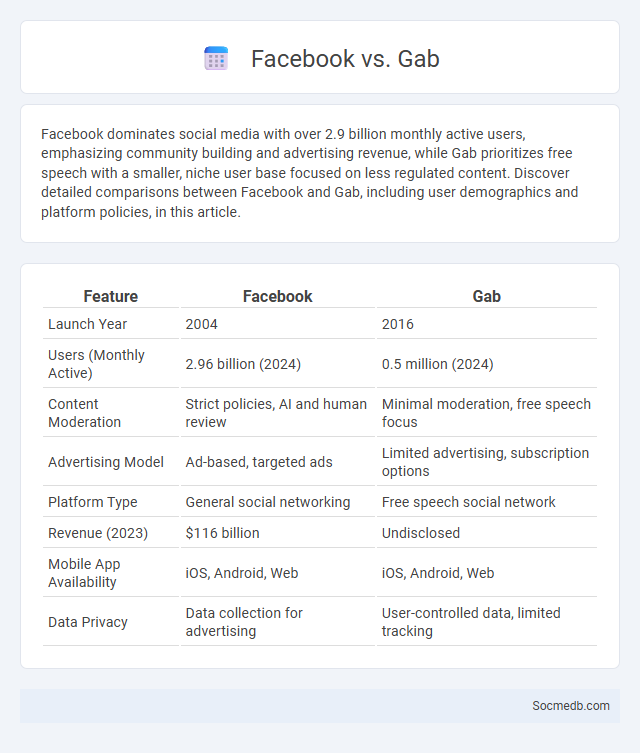
Photo illustration: Facebook vs Gab
Facebook dominates social media with over 2.9 billion monthly active users, emphasizing community building and advertising revenue, while Gab prioritizes free speech with a smaller, niche user base focused on less regulated content. Discover detailed comparisons between Facebook and Gab, including user demographics and platform policies, in this article.
Table of Comparison
| Feature | Gab | |
|---|---|---|
| Launch Year | 2004 | 2016 |
| Users (Monthly Active) | 2.96 billion (2024) | 0.5 million (2024) |
| Content Moderation | Strict policies, AI and human review | Minimal moderation, free speech focus |
| Advertising Model | Ad-based, targeted ads | Limited advertising, subscription options |
| Platform Type | General social networking | Free speech social network |
| Revenue (2023) | $116 billion | Undisclosed |
| Mobile App Availability | iOS, Android, Web | iOS, Android, Web |
| Data Privacy | Data collection for advertising | User-controlled data, limited tracking |
Understanding Facebook and Gab: An Overview
Facebook remains a dominant social media platform with over 2.9 billion monthly active users, offering extensive features for personal networking, business marketing, and community building. Gab positions itself as an alternative platform emphasizing free speech, attracting users who seek less moderation and a different content governance model. Understanding the distinct user bases and content policies of Facebook and Gab is crucial for targeted social media strategies and engagement analysis.
The Rise of Fake News on Social Platforms
The rise of fake news on social media platforms has significantly impacted public discourse, spreading misinformation rapidly across networks like Facebook, Twitter, and Instagram. Algorithms that prioritize engagement often amplify sensational or misleading content, making it difficult for users to discern credible information from falsehoods. Efforts by tech companies to implement fact-checking tools and content moderation policies face challenges adapting to the evolving tactics of fake news creators.
Content Moderation: Facebook vs Gab Approaches
Facebook employs an advanced AI-driven content moderation system combined with a large team of human reviewers to enforce community standards and remove harmful content swiftly. Gab, prioritizing free speech, relies mainly on user reporting and minimal automated moderation, often resulting in more lenient content policies and slower removal of hateful or extremist material. These contrasting approaches highlight the trade-off between aggressive moderation for user safety and permissive policies to protect free expression on social media platforms.
Algorithms and the Spread of Misinformation
Social media platforms utilize complex algorithms designed to maximize user engagement by prioritizing content that elicits strong reactions, often amplifying sensational or misleading information. These algorithms analyze user behavior, preferences, and interactions to curate personalized feeds, inadvertently creating echo chambers that reinforce existing beliefs and facilitate the rapid spread of misinformation. The viral nature of algorithm-driven content distribution poses significant challenges for fact-checking efforts and the mitigation of false narratives across digital networks.
User Demographics and Community Culture
Social media platforms exhibit distinct user demographics, with younger audiences dominating Instagram and TikTok, while Facebook maintains a broader age range. Community culture varies significantly, influenced by platform norms, content types, and user interaction styles, fostering environments from professional networking on LinkedIn to casual sharing on Snapchat. Understanding these dynamics helps tailor content strategies and enhances engagement by aligning with specific audience behaviors and cultural expectations.
Fact-Checking Mechanisms: Effectiveness and Limitations
Fact-checking mechanisms on social media employ machine learning algorithms and network analysis to identify and flag misinformation rapidly, significantly curbing the spread of false content. However, these mechanisms face limitations such as algorithmic biases, delayed verification processes, and the challenge of distinguishing nuanced information from deliberate misinformation. Continuous improvements in AI models and collaborative efforts with human fact-checkers are essential to enhance accuracy and reliability in real-time content moderation.
Freedom of Speech vs Platform Responsibility
Social media platforms balance freedom of speech with platform responsibility by enforcing community guidelines while respecting users' rights to express opinions. Your online interactions reflect a complex ecosystem where protecting free expression must coexist with preventing harmful content and misinformation. Ensuring this balance requires transparent policies and proactive moderation to foster healthy digital communication.
Case Studies: Viral Fake News Incidents
Viral fake news incidents such as the 2016 U.S. election misinformation campaign and the COVID-19 conspiracy theories demonstrate how social media platforms amplify false narratives rapidly. These case studies reveal the critical role of algorithmic biases and user echo chambers in spreading misleading content, impacting public opinion and trust. Understanding these patterns can help you critically evaluate online information and recognize the societal consequences of unchecked fake news proliferation.
Impacts on Public Opinion and Elections
Social media platforms significantly influence public opinion and election outcomes by amplifying both accurate information and misinformation rapidly. Algorithms prioritize engaging content, often creating echo chambers that reinforce existing beliefs and polarize voters. Your exposure to diverse viewpoints can shape political perceptions and sway electoral decisions in unprecedented ways.
Future Challenges: Combating Fake News on Social Media
Combating fake news on social media poses a significant future challenge as misinformation spreads rapidly across platforms, influencing public opinion and decision-making. Advanced algorithms and fact-checking technologies must evolve to detect and reduce the impact of false content effectively. Your ability to critically assess information and use verified sources remains crucial in navigating this complex digital landscape.
 socmedb.com
socmedb.com